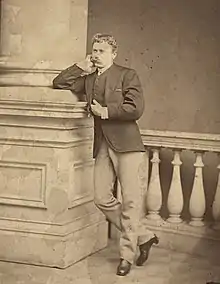Lorentz Severin Skougaard | |
|---|---|
_-_no-nb_digifoto_20150106_00003_blds_06763_(cropped).jpg.webp) | |
| Born | 11 May 1837 Farsund, Norway |
| Died | 14 February 1885 (aged 47) New York City, U.S. |
| Occupation | Singer |
| Partner | Alfred Corning Clark |
Lorentz Severin Skougaard (11 May 1837 - 14 February 1885) was a Norwegian tenor.
Early life

Lorentz Severin Skougaard was born on 11 May 1837 in Farsund, Norway, the son of Jonas Eilertsen Lund Schougaard (1807-1877) and Sara Helene Jonasdatter Lund (1813-1910).
At first he was a trading officer, working at first in Memel, Norway, and then London. Later he moved to Paris and Italy to study music.[1]
Career
In 1864 Lorentz Severin Skougaard sang in Stockholm, Berlin and Christiania. In Paris in 1866, he met Alfred Corning Clark.[2]
In 1866 Skougaard gave a series of recitals in New York City in conjunction with Alfred H. Pease at the Irving Hall. The recitals introduced him favorably to the New York public and he became a successful vocal teacher.[3] In 1874 he have a charitable concert at the Steinway Hall in aid of the Scandinavian poor of New York City. There were a large number of performers and it was under the patronage of many prominent persons.[4]
Personal life
.JPG.webp)
Lorentz Severin Skougaard moved to the United States in 1866.[3] In 1869, the same year when he married, Clark began making annual summer visits to Norway with Skougaard, eventually building a house on an island near Skougaard's family home.[3][2] Clark's son, born in 1870, bears the middle name of Severin. When in New York City, Skougaard lived in Clark's flat at 64 West 22nd Street.[5] The apartment was a favorite evening resort for music lovers, attracted by Skougaard's very companionable qualities, and the house for years was known as "Severini Hall".[3][6] According to Nicholas Fox Weber's biographer of the Clark family (The Clarks of Cooperstown, 2007), Clark led a double life, in the United States a family man, in Europe a gay aesthete. For 19 years his closest companion was Skougaard.[3][7][8]
On 14 February 1885, in New York City, Skougaard died of typhoid fever.[2][3]
Legacy
Clark eulogized him in a privately published biographical sketch, Lorentz Severin Skougaard : a sketch, mainly autobiographic[9] and created a $64,000 endowment in his memory for Manhattan's Norwegian Hospital, 4th Avenue & 46th Street.[10]
Clark also commissioned Brotherly Love (1886–87) to American sculptor George Grey Barnard to adorn his friend's grave in Langesund, Norway.[11] The homoerotic sculpture depicts two nude male figures blindly reaching out to each other through the block of marble that separates them.[12] Later Clark moved Barnard to New York City and maintained him.[13]
References
- ↑ Haandlexikon, Norsk. "Skougaard, Lorentz Severin, Norsk Haandlexikon (1881-1888)". Retrieved 7 January 2018.
- 1 2 3 Harold E. Dickson, "Barnard and Norway," The Art Bulletin, vol. 44, no. 1 (March 1962), pp. 55-59.(JSTOR) $
- 1 2 3 4 5 6 "L. Skougaard Severini - 15 Feb 1885, Sun • Page 2". The New York Times: 2. 1885. Retrieved 7 January 2018.
- ↑ "Charitable Concert - 17 Jan 1874, Sat • Page 4". The New York Times: 4. 1874. Retrieved 7 January 2018.
- ↑ Applegate, Debby (20 May 2007). "The Clarks of Cooperstown - Nicholas Fox Weber - Books - Review". The New York Times. Retrieved 11 December 2019.
- ↑ Nicholas Fox Weber, The Clarks of Cooperstown: Their Singer Sewing Machine Fortune, Their Great and Influential Art Collections, Their Forty-year Feud. Alfred A. Knopf, 2007. ISBN 0307263479, pg. 76
- ↑ Debby Applegate, "Outrageous Fortune," The New York Times Book Review, 20 May 2007.
- ↑ Buckman, Jack (2016). Unraveling The Threads: The Life, Death and Resurrection of the Singer Sewing Machine Company, America's First Multi-National Corporation. Dog Ear Publishing. p. 102. ISBN 9781457546617. Retrieved 7 January 2018.
- ↑ Alfred Corning Clark, Lorentz Severin Skougaard: a sketch, mainly autobiographic, (privately published, 1885), from WorldCat.
- ↑ The Brooklyn Daily Eagle, 26 January 1911, p. 1.
- ↑ Glenn C. Altschuler, "Meet 3 Generations of American Originals," The Baltimore Sun, 17 June 2007.
- ↑ "George Grey Barnard (1863 – 1938)," in Lauretta Dimmick and Donna J. Hassler. American Sculpture in the Metropolitan Museum of Art: A catalogue of works by artists born before 1865. Metropolitan Museum of Art, 1999. pp. 421-27.
- ↑ Applegate, Debby (18 May 2007). "Book Review: The Clarks of Cooperstown". The New York Times. Retrieved 11 December 2019.